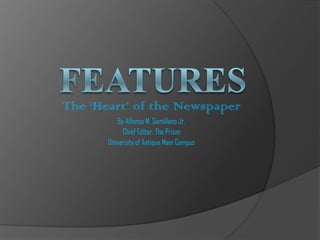Features ppt
- 1. The ‘Heart’ of the Newspaper By Alfonso M. Samillano Jr. Chief Editor, The Prism University of Antique Main Campus
- 2.  The so-called „heart‟ of the publication Written to entertain for lighter reading Action-packed Comments, dialogs, personalities carry the story Like news, it is factual in approach but differs in structure Independent from element of timeliness for it to attract reader attention
- 3. Never uses the inverted pyramid format Focuses on what‟s most interesting Starts with a description – either a mood or a setting Hardly starts with a direct quotation Runs beyond one sentence, usually five or six paragraphs Attribution is delayed
- 4. News Features - explores news stories in details Personality sketch – facts centered on a person Q 7 A Issue-oriented – examines trends and controversies Seasonal – special occasssions (Cristmas, Holy Week, etc) Bright Feature – it‟s a „little funny‟, unusual story
- 5. Something-Out-of-Nothing – about something ordinary Historical – focuses on history of an event Travel – destinations, points of interest, what they offer, etc. First-Person – written only when a person experienced an extraordinary event Consumer-Oriented – business, products and services Practical guidance – the how-to articles, tips on almost about anything
- 6. News Feature A summary lead that tells the beginning, middle and end of the story. Example: Hundreds of elite soldiers are scouring the rugged terrains of San Remigio in search for members of NPA responsible for beheading government operatives more than two weeks Quotation Lead Prefers short and dramatic but summarizes the theme, otherwise this is seldom used. Example: “When my husband died, I lost my life, too. I can‟t remember anything now. I died with him.” (American Magazine)
- 7. Direct Address Use the pronoun ‘you’ in consumer-oriented pieces and related stories. Example: “You‟re in a jeepney and someone pokes his knife on your side demanding: “Give me your cellphone.” What do you do when you know he has three companions around you? (POLICE FILES) Play of Words Use of puns or jokes Example: „Tubig.‟ It is a problem too big to solve in the metropolis. (Unang Hirit)
- 8. Question Sometimes this works, but sometimes it could be silly. Example: What does an anti-war organization do when the war is over? Suspense Short leads that lead to suspenseful development Example: Three weeks ago, Milagring Corring bought a stack of travel books and maps for the planned cross-country adventure with her husband. They left home Friday last week. Three days later, she bought him a casket.
- 9.  Anecdote lead Tells a brief story applicable to the key issue of the feature Example: Every morning, Sixto wakes up before 5 a.m. when the roosters sing their symphony at dawn. He would stretch first, and jump out of bed and do his usual 50-count push ups. “I don‟t drink. I don‟t smoke and at 50, I can still run almost as fast as my 16-yearl-old boy,” says Sixto, who attribute his fitness to good diet, enough sleep and exercises. Physical Description Describes a person especially his/her physical attributes. Example: Sixty-two-year old Olayra Perez, unlike other women her age, has remained almost a fountain of youth. Her face hardly has wrinkles, and her sister swears Olayra‟s looks were almost the same when she was 25.
- 10.  Descriptive lead Making things highly visual for the reader is the hallmark of this type of lead. Scenes, individuals, events and moods are described clearly and precisely as the situation takes place. Example: Dawn has yet to break and yet, informal settlers in Brgy. Tuburan were all running towards the lone water faucet with their red and blue buckets of different sizes. To them who have been waterless for a week, the steady sound of dripping water is like a wave of relief. Young and old, employed and jobless, they all crowd expectantly, willing the faucet to spew a steady stream of water.
- 11. How to Paint Word Pictures
- 12. By being specific with details, the writer is able to control what he exactly wants the reader to see in his mind‚Äüs eye. Not specific : She appreciated the beauty of the sampaguita in her mother‚Äüs garden Specific : Luisa‚Äüs heart warmed upon seeing the sampaguita‚Äüs long stems coiling around the trellis, white flowers perfuming the late afternoon air in her mother‚Äüs well-tended garden.
- 13. Making something lifeless or inert come alive with the use of words that refer to living things has an effect on the reader. Inanimate : Leaves were on the floor. Animate : Leaves lie on the floor.
- 14. Show what happened and don‟t merely tell about it. Elaborate on a feature theme‟s important scene or event by describing how the subject feels. Tell : John was happy when he received his package. Show : John, 8, excitedly opened the package from his sponsor. His eyes lit up and a broad smile appeared on his face. “I love the toys! They‟re beautiful!” he said with a giggle.
- 15. Write a descriptive lead centered on the goings-on at your town public market during Market day.
- 16. References: Feature Writing from the lectures of Hazel P. Villa, Iloilo City, Philippines Feature Writing from the lecture of Eric T. Loretizo, PIA Region 6, Iloilo City















